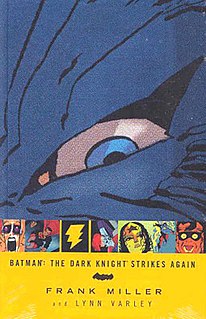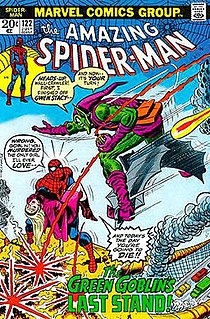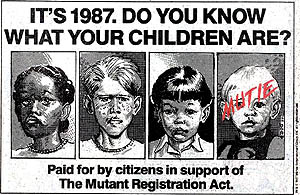
A superhero or superheroine is a stock character that possesses abilities beyond those of ordinary people, who typically uses his or her powers to help the world become a better place, or is dedicated to protecting the public, and fighting crime. Superhero fiction is the genre of fiction that is centered on such characters, especially in American comic books since the 1930s, as well as in Japanese media since the 1930s.

The DC Universe (DCU) is the fictional shared universe where most stories in American comic book titles published by DC Comics take place. DC superheroes such as Superman, Batman, Wonder Woman, Martian Manhunter, The Flash, Green Lantern, and Aquaman are from this universe, and it also contains well-known supervillains such as Lex Luthor, the Joker, Brainiac, Gorilla Grodd, Sinestro, Deathstroke, Cheetah, and Darkseid. In context, the term "DC Universe" usually refers to the main DC continuity.

Captain Marvel, also known as Shazam, is a fictional superhero appearing in American comics originally published by Fawcett Comics, and currently published by DC Comics. Artist C. C. Beck and writer Bill Parker created the character in 1939. Captain Marvel first appeared in Whiz Comics #2, published by Fawcett Comics. He is the alter ego of Billy Batson, a boy who, by speaking the magic word "SHAZAM!", can transform himself into a costumed adult with the powers of superhuman strength, speed, flight and other abilities. The character battles an extensive rogues' gallery, most of them working in tandem as the Monster Society of Evil, including primary archenemies Doctor Sivana, Black Adam, and Mister Mind.

Kingdom Come is a four-issue comic book miniseries published in 1996 by DC Comics under their Elseworlds imprint. It was written by Mark Waid and Alex Ross and painted in gouache by Ross, who also developed the concept from an original idea. This Elseworlds story is a deconstructionist tale set in a future that deals with a growing conflict between the visibly out-of-touch "traditional" superheroes, and a growing population of largely amoral and dangerously irresponsible new vigilantes, in many cases the offspring of the traditional heroes. Between these two groups is Batman and his assembled team, who attempt to contain the escalating disaster, foil the machinations of Lex Luthor, and prevent a world-ending superhuman war.

Batman: The Dark Knight Strikes Again, also known as DK2, is a 2001-2002 DC Comics three-issue limited series comic book written and illustrated by Frank Miller and colored by Lynn Varley, featuring the fictional superhero Batman. The series is a sequel to Miller's 1986 miniseries The Dark Knight Returns. It tells the story of an aged Bruce Wayne who returns from three years in hiding, training his followers and instigating a rebellion against Lex Luthor's dictatorial rule over the United States. The series features an ensemble cast of superheroes including Catgirl, Superman, Wonder Woman, Plastic Man, The Flash, and the Atom.

In the comic book fan community, the apparent death and subsequent return of a long-running character is often called a comic book death. A comic book death is generally not taken seriously by readers and is rarely permanent or meaningful other than for story or thematic purposes. The term is usually not applied to characters who have the ability to return from the dead as an established power or ability, such as Solomon Grundy or Ra's al Ghul.
A superhero film is a film that is focused on the actions of one or more superheroes: individuals who usually possess extraordinary – generally superhuman – abilities relative to a normal person and are dedicated to protecting the public. These films typically feature action, adventure, fantasy or science fiction elements, with the first film of a particular character often including a focus on the origin of their special powers and their first confrontation with their most famous supervillain or archenemy.

The Bronze Age of Comic Books is an informal name for a period in the history of American superhero comic books usually said to run from 1970 to 1984. It follows the Silver Age of Comic Books and is followed by the Modern Age of Comic Books.
Arabian Knight is a title used by multiple fictional characters appearing in American comic books published by Marvel Comics.

The Registration Acts—the Mutant Registration Act (MRA), the Keene Act, the Superhuman Registration Act, the Sokovia Accords the Vigilante Registration Act (VRA), and the Underage Superhuman Welfare Act —are fictional legislative bills that have been plot points used in various comic books and superhero films which, when passed into law, enforce the regulation of extra legal vigilante activity vs. criminal activity or the mandatory registration of superpowered individuals with the government.

The character of Superman, also known as Kal-El from Krypton, who adopts the identity of Clark Kent when not fulfilling his superhero role, was created by Jerry Siegel and Joe Shuster, and has been continually published in a variety of DC Comics book titles since its premiere in 1938. There have been several versions of Superman over the years, both as the main hero in the stories as well as several alternative versions.

Amazing-Man is a fictional, American comic book superhero whose adventures were published by Centaur Publications during the 1930s to 1940s in the Golden Age of Comic Books. Historians credit his creation variously to writer-artist Bill Everett or to Everett together with Centaur art director Lloyd Jacquet. Amazing-Man first appeared in Amazing-Man Comics #5.
One of the key aspects of the Modern Age of Comic Books was that it was the beginning of big events. In 1984, Marvel Comics debuted the first large crossover, Secret Wars, a storyline featuring the company's most prolific superheroes, which overlapped into a 12-issue limited series and many monthly comic books. A year later, DC Comics introduced its first large scale crossover, Crisis on Infinite Earths, which had long-term effects on the "DC Universe" continuity.

Superhero fiction is a genre of speculative fiction examining the adventures, personalities and ethics of costumed crime fighters known as superheroes, who often possess superhuman powers and battle similarly powered criminals known as supervillains. The genre primarily falls between hard fantasy and soft science fiction spectrum of scientific realism. It is most commonly associated with American comic books, though it has expanded into other media through adaptations and original works.

Superhero comics are one of the most common genres of American comic books. The genre rose to prominence in the 1930s and became extremely popular in the 1940s and has remained the dominant form of comic book in North America since the 1960s. Superhero comics feature stories about superheroes and the universes these characters inhabit.

In superhero comic books, a team-up is a fictional crossover where two or more superheroes or superhero teams who usually do not appear together work together on a shared goal.










